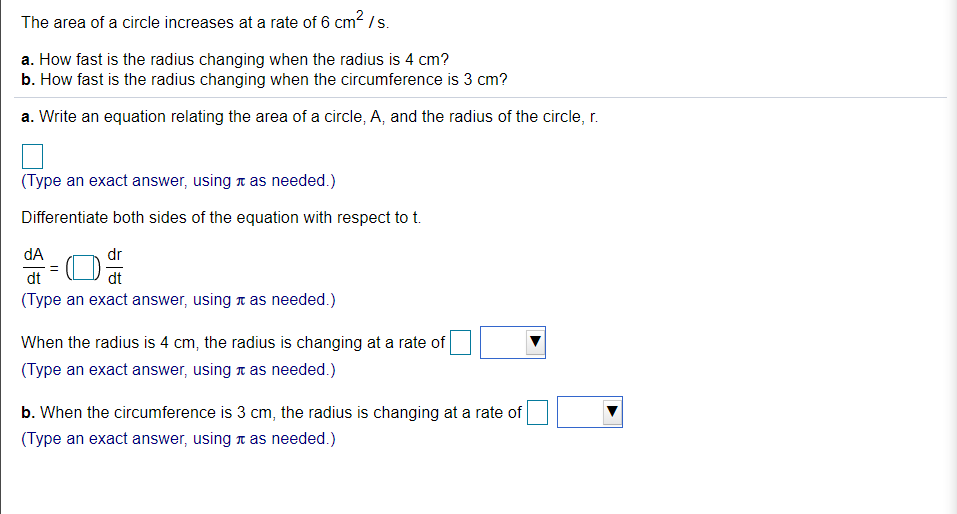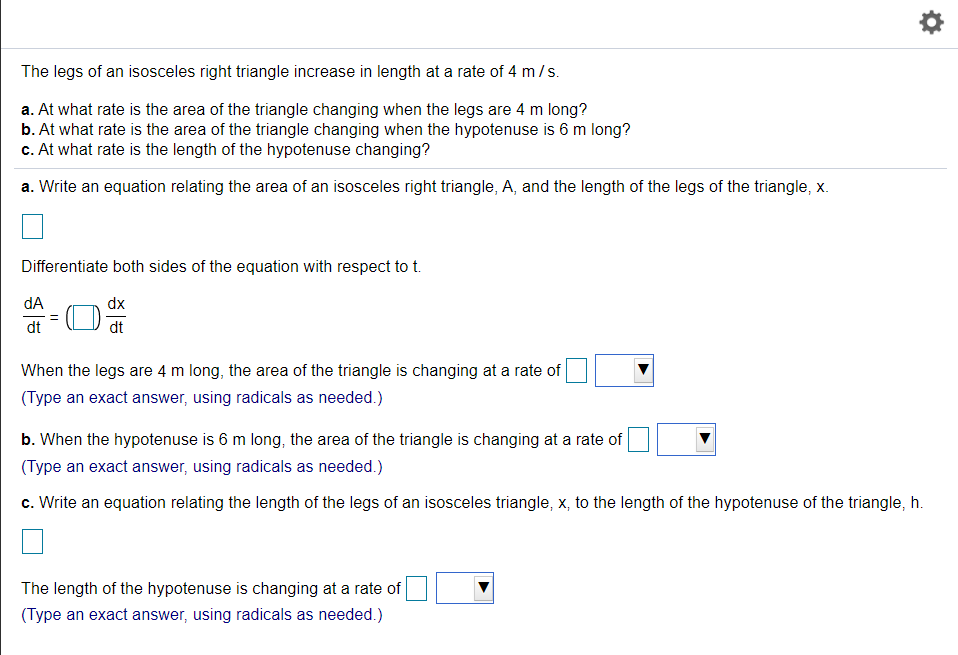The area of a circle increases at a rate of 6 cm? / s. a. How fast is the radius changing when the radius is 4 cm? b. How fast is the radius changing when the circumference is 3 cm? a. Write an equation relating the area of a circle, A, and the radius of the circle, r. (Type an exact answer, using t as needed.) Differentiate both sides of the equation with respect to t. dA dr dt dt (Type an exact answer, using a as needed.) When the radius is 4 cm, the radius is changing at a rate of (Type an exact answer, using t as needed.) b. When the circumference is 3 cm, the radius is changing at a rate of (Type an exact answer, using t as needed.)
The area of a circle increases at a rate of 6 cm? / s. a. How fast is the radius changing when the radius is 4 cm? b. How fast is the radius changing when the circumference is 3 cm? a. Write an equation relating the area of a circle, A, and the radius of the circle, r. (Type an exact answer, using t as needed.) Differentiate both sides of the equation with respect to t. dA dr dt dt (Type an exact answer, using a as needed.) When the radius is 4 cm, the radius is changing at a rate of (Type an exact answer, using t as needed.) b. When the circumference is 3 cm, the radius is changing at a rate of (Type an exact answer, using t as needed.)
Linear Algebra: A Modern Introduction
4th Edition
ISBN:9781285463247
Author:David Poole
Publisher:David Poole
Chapter6: Vector Spaces
Section6.7: Applications
Problem 13EQ
Related questions
Question

Transcribed Image Text:The area of a circle increases at a rate of 6 cm2/s.
a. How fast is the radius changing when the radius is 4 cm?
b. How fast is the radius changing when the circumference is 3 cm?
a. Write an equation relating the area of a circle, A, and the radius of the circle, r.
(Type an exact answer, using t as needed.)
Differentiate both sides of the equation with respect to t.
dA
dr
dt
dt
(Type an exact answer, using t as needed.)
When the radius is 4 cm, the radius is changing at a rate of
(Type an exact answer, using a as needed.)
b. When the circumference is 3 cm, the radius is changing at a rate of
(Type an exact answer, using a as needed.)

Transcribed Image Text:The legs of an isosceles right triangle increase in length at a rate of 4 m /s.
a. At what rate is the area of the triangle changing when the legs are 4 m long?
b. At what rate is the area of the triangle changing when the hypotenuse is 6 m long?
c. At what rate is the length of the hypotenuse changing?
a. Write an equation relating the area of an isosceles right triangle, A, and the length of the legs of the triangle, x.
Differentiate both sides of the equation with respect to t.
dA
dx
dt
dt
When the legs are 4 m long, the area of the triangle is changing at a rate of
(Type an exact answer, using radicals as needed.)
b. When the hypotenuse is 6 m long, the area of the triangle is changing at a rate of
(Type an exact answer, using radicals as needed.)
c. Write an equation relating the length of the legs of an isosceles triangle, x, to the length of the hypotenuse of the triangle, h.
The length of the hypotenuse is changing at a rate of
(Type an exact answer, using radicals as needed.)
Expert Solution
This question has been solved!
Explore an expertly crafted, step-by-step solution for a thorough understanding of key concepts.
This is a popular solution!
Trending now
This is a popular solution!
Step by step
Solved in 4 steps with 4 images

Knowledge Booster
Learn more about
Need a deep-dive on the concept behind this application? Look no further. Learn more about this topic, calculus and related others by exploring similar questions and additional content below.Recommended textbooks for you

Linear Algebra: A Modern Introduction
Algebra
ISBN:
9781285463247
Author:
David Poole
Publisher:
Cengage Learning

Algebra & Trigonometry with Analytic Geometry
Algebra
ISBN:
9781133382119
Author:
Swokowski
Publisher:
Cengage

Mathematics For Machine Technology
Advanced Math
ISBN:
9781337798310
Author:
Peterson, John.
Publisher:
Cengage Learning,

Linear Algebra: A Modern Introduction
Algebra
ISBN:
9781285463247
Author:
David Poole
Publisher:
Cengage Learning

Algebra & Trigonometry with Analytic Geometry
Algebra
ISBN:
9781133382119
Author:
Swokowski
Publisher:
Cengage

Mathematics For Machine Technology
Advanced Math
ISBN:
9781337798310
Author:
Peterson, John.
Publisher:
Cengage Learning,

Elementary Geometry for College Students
Geometry
ISBN:
9781285195698
Author:
Daniel C. Alexander, Geralyn M. Koeberlein
Publisher:
Cengage Learning

Algebra: Structure And Method, Book 1
Algebra
ISBN:
9780395977224
Author:
Richard G. Brown, Mary P. Dolciani, Robert H. Sorgenfrey, William L. Cole
Publisher:
McDougal Littell